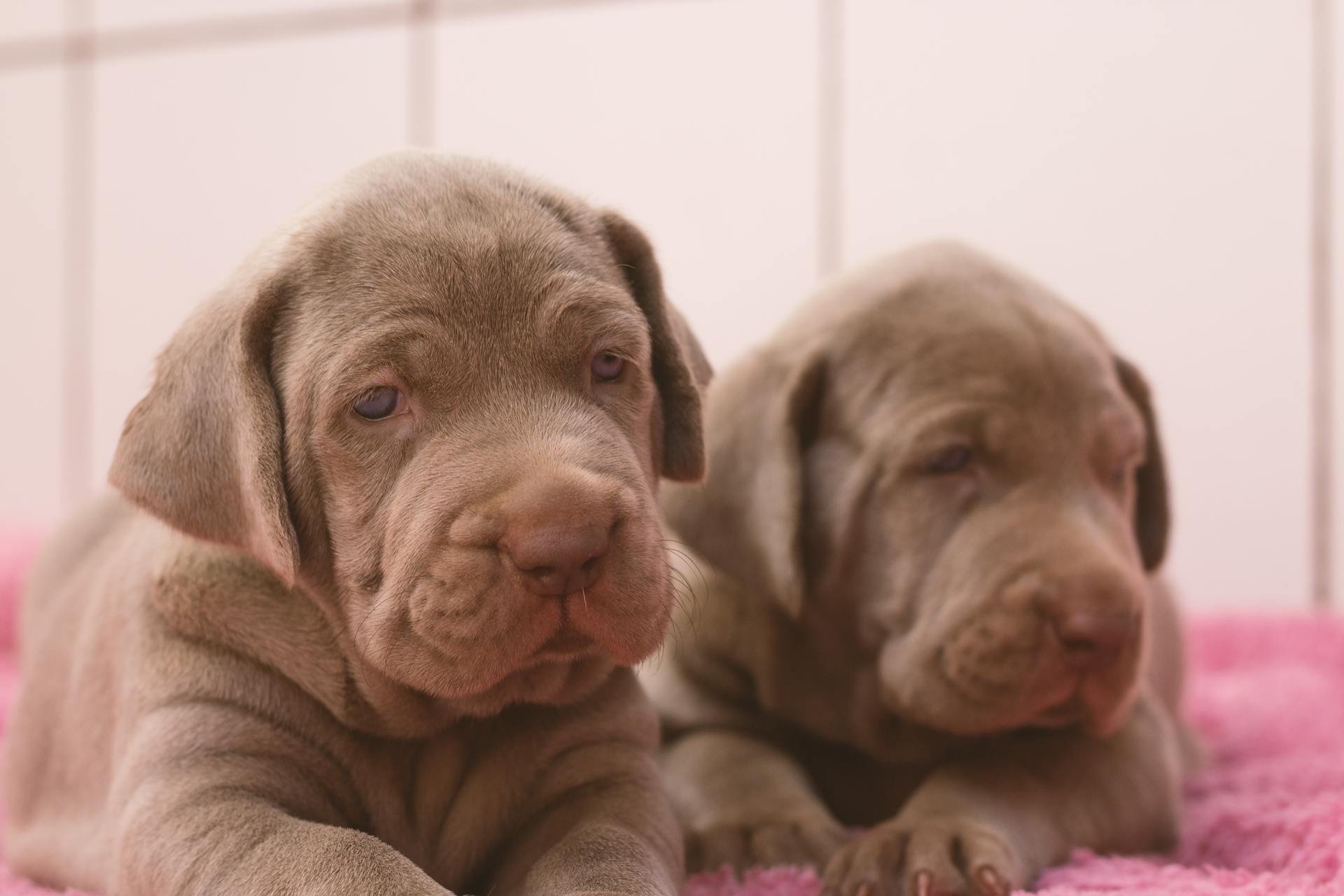
Reverse sneezing in cats can be a distressing sight, especially if you've never seen it before. A cat's airway is narrower than a human's, making them more prone to this condition.
The most common cause of reverse sneezing in cats is an irritant in the nasal passage, such as dust, pollen, or a foreign object. This can trigger a sudden, intense spasming of the muscles in the cat's throat.
As a cat owner, it's essential to recognize the signs of reverse sneezing, which can include rapid, shallow breathing, a blue-tinged tongue, and a loud, high-pitched sound.
Here's an interesting read: Why Is My Cat's Hair Standing Up?
Causes and Symptoms
Reverse sneezing in cats can be a concerning sight, but understanding the causes and symptoms can help alleviate your worries. Cats reverse sneeze to clear out whatever is blocking or scratching the nose, mouth, or throat.
Common causes of reverse sneezing include allergens, foreign objects, foreign substances, nasal polyps, upper respiratory tract infections, rhinitis, nasal mites, brachycephalic airway syndrome, intranasal vaccinations, eating and drinking quickly, and overexcitement. These irritants can cause your cat to sneeze in reverse, trying to expel the unwanted substance.
During a reverse sneezing episode, your cat will display abrupt and frequent inhalations through the nose, which can be quite loud, resembling a snorting or gasping sound. They might also stretch out their head and neck, stand still, and maintain a rigid body posture.
Some of the symptoms of reverse sneezing in cats include:
- Abrupt, frequent inhalations
- Extension of the head and neck
- Audible snorting sounds
- Rigid body posture
- Brief duration
These symptoms are usually not a serious health threat to cats, but if you're uncertain whether your cat is experiencing a reverse sneeze or if the frequency of sneezing becomes chronic, it's always best to consult with a veterinarian for a proper evaluation and guidance.
Diagnosis and Treatment
Diagnosing reverse sneezing in cats can be a challenge, especially if it's the first time you've seen it happen.
A veterinarian will typically do a complete physical exam to check for any obvious abnormalities, such as a visible foreign object in the nose or discharge from an upper respiratory tract infection.
If your cat has an episode while at the veterinary hospital, diagnosing reverse sneezing is relatively simple.
However, most of the time, this doesn't happen, and you'll need to provide a video of the episode to help the veterinarian make a correct diagnosis.
Pet parents should also mention what the cat was doing just before the sneezing fit, as this information can be helpful in determining the underlying cause.
- Gently rubbing the cat's throat or blowing air softly at his face can help the symptoms clear up during an episode.
- Covering the cat's nostrils for a couple of seconds can also reset his breathing by stopping air from entering his nose and making him swallow.
If your cat has repeated bouts of reverse sneezing, treating the underlying cause can be helpful.
Common underlying causes include nasal mites, nasal inflammation, respiratory tract infections, and allergies.
Understanding Reverse Sneezing
Reverse sneezing in cats is a common phenomenon that can be alarming for pet parents, but it's usually not a cause for concern. It typically lasts less than a minute and can be triggered by an irritant in the nose, mouth, or throat.
A cat experiencing a reverse sneezing episode will often display abrupt and frequent inhalations, accompanied by snorting or gasping sounds. They may also extend their head and neck, and maintain a rigid body posture.
Here are some common signs of reverse sneezing in cats:
- Abrupt, frequent inhalations
- Extension of the head and neck
- Audible snorting sounds
- Rigid body posture
If you're unsure whether your cat is experiencing a reverse sneeze or if the frequency of sneezing becomes chronic, it's always a good idea to consult with a veterinarian for a proper evaluation and guidance.
What Is?
Reverse sneezing in cats is a relatively common phenomenon, but it can be alarming for pet parents. Typically, a reverse sneezing episode in a cat lasts less than a minute, but it can seem much longer.
During a reverse sneezing episode, a cat's trachea squeezes and the muscles of the oral cavity spasm, making it difficult for them to inhale fully. This can cause repeated short, noisy bouts of breathing in.
A cat experiencing a reverse sneezing episode may display a rigid body posture, with their body and legs relatively motionless. They could stand still or bend slightly over.
Reverse sneezing sounds like a pet snorting, with quick, short breaths that repeat for several seconds. It may even look like the cat is trying to vomit as their neck stretches out.

The symptoms of reverse sneezing in cats include abrupt, frequent inhalations, extension of the head and neck, audible snorting sounds, and a brief duration of the episode. Here are the common symptoms:
- Abrupt, frequent inhalations
- Extension of the head and neck
- Audible snorting sounds
- Rigid body posture
- Brief duration
Reverse sneezing is not as routine in felines as it is in canines, but it is usually not serious and nothing to worry about as long as it does not continue for a long time.
Is an Emergency?
Reverse sneezing episodes in cats are generally short-lived and cats return to normal quickly.
However, it's essential to note that reverse sneezing can look similar to other more serious conditions, such as choking or difficulty breathing.
These are emergencies that need immediate medical attention, so it's crucial to know the difference.
If this is the first time your cat is having what looks like reverse sneezing, it's a good idea to bring her to the veterinarian to ensure nothing more serious is going on.
Prevention and Care
To help prevent or minimize episodes of reverse sneezing in cats, pet owners can consider the following.
Pet owners can help prevent or minimize episodes of reverse sneezing by taking steps to reduce their cat's stress and anxiety.
Gently stroking or calming your cat during an episode can help comfort them and make the experience less distressing.
In mild cases of reverse sneezing, veterinarians may recommend a watchful waiting approach, reassuring the owner that reversing sneezing is usually harmless and self-limiting.
Cat Prevention
Prevention is key to keeping your cat happy and healthy. To help prevent or minimize episodes of reverse sneezing in cats, pet owners can consider the following.
Pet owners can keep their cat's environment clean by regularly vacuuming and dusting to reduce allergens and irritants.
Keeping your cat at a healthy weight can also help prevent reverse sneezing.
Regular grooming can help remove hair and other debris that may cause irritation.
Reducing stress and anxiety in your cat can also help prevent reverse sneezing episodes.
Reassurance and Observation
If your cat is experiencing mild reverse sneezing, your veterinarian may recommend a watchful waiting approach. This means you'll need to observe your cat's episodes closely and take note of how often they occur and how severe they are.
Reassuring your cat during an episode can be as simple as gently stroking or calming them down. This can help your cat feel more at ease and reduce stress.
Veterinarians often advise owners that reversing sneezing is usually harmless and self-limiting, so it's essential to remain calm and not panic.
Is My Dog Healthy?
If your dog is experiencing a loud snorting sound that sounds like a goose honking, they might be reverse sneezing.
Reverse sneezing is usually a temporary condition that lasts about 30 seconds, and your dog will be completely normal before and after the episode.
It's essential to observe your dog's behavior and watch for signs of distress, such as lethargy, coughing, increased respiratory rate or effort, or difficulty breathing.
If you notice any of these signs, seek immediate veterinary care.
Frequently Asked Questions
How to stop a reverse sneeze in cats?
To stop a reverse sneeze in cats, try massaging the cat's throat or momentarily blocking their nostrils to help them swallow and clear the irritation. This gentle technique can help alleviate the episode without causing harm to your feline friend.
What does it look like when a cat reverse sneezes?
When a cat reverse sneezes, they typically stand still with their head and neck stretched out and make unusual snorting or honking sounds
What does reverse sneezing sound like?
A reverse sneeze sounds like a sudden, forceful inhalation, often described as a "whooping" or "gasping" sound, and can be a bit uncomfortable.
Sources
- Is That a Sneeze? Reverse Sneezing in Dogs (ethosvet.com)
- Reverse Sneezing in Cats - Causes, Treatment and ... (vetster.com)
- Reverse Sneezing in Cats: Is it Normal? (petcheckurgentcare.com)
- Reverse Sneeze In Cats - Causes, Symptoms & Treatment (beyondpets.com)
- Reverse Sneezing in Cats: What Causes It and When To ... (petmd.com)
Featured Images: pexels.com


